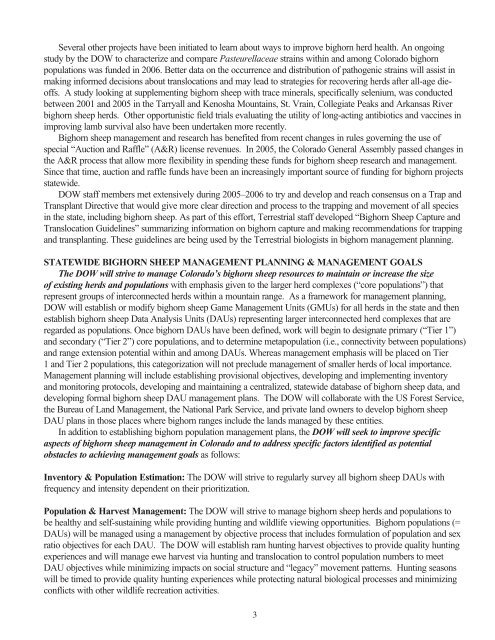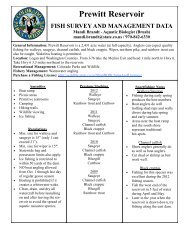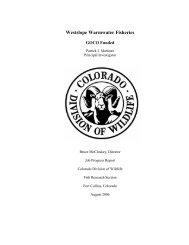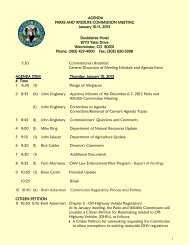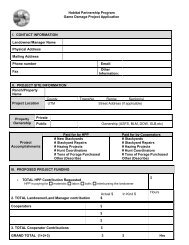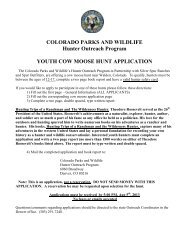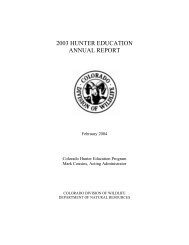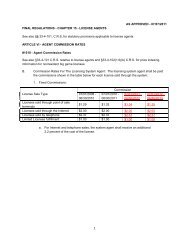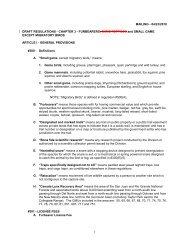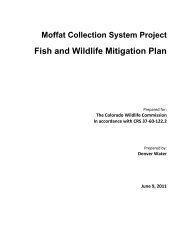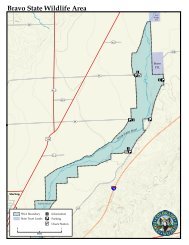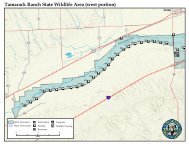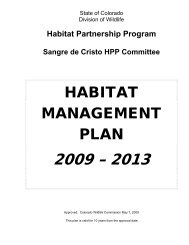COLORADO BIGHORN SHEEP MANAGEMENT PLAN 2009−2019
COLORADO BIGHORN SHEEP MANAGEMENT PLAN 2009−2019
COLORADO BIGHORN SHEEP MANAGEMENT PLAN 2009−2019
You also want an ePaper? Increase the reach of your titles
YUMPU automatically turns print PDFs into web optimized ePapers that Google loves.
Several other projects have been initiated to learn about ways to improve bighorn herd health. An ongoing<br />
study by the DOW to characterize and compare Pasteurellaceae strains within and among Colorado bighorn<br />
populations was funded in 2006. Better data on the occurrence and distribution of pathogenic strains will assist in<br />
making informed decisions about translocations and may lead to strategies for recovering herds after all-age dieoffs.<br />
A study looking at supplementing bighorn sheep with trace minerals, specifically selenium, was conducted<br />
between 2001 and 2005 in the Tarryall and Kenosha Mountains, St. Vrain, Collegiate Peaks and Arkansas River<br />
bighorn sheep herds. Other opportunistic field trials evaluating the utility of long-acting antibiotics and vaccines in<br />
improving lamb survival also have been undertaken more recently.<br />
Bighorn sheep management and research has benefited from recent changes in rules governing the use of<br />
special “Auction and Raffle” (A&R) license revenues. In 2005, the Colorado General Assembly passed changes in<br />
the A&R process that allow more flexibility in spending these funds for bighorn sheep research and management.<br />
Since that time, auction and raffle funds have been an increasingly important source of funding for bighorn projects<br />
statewide.<br />
DOW staff members met extensively during 2005–2006 to try and develop and reach consensus on a Trap and<br />
Transplant Directive that would give more clear direction and process to the trapping and movement of all species<br />
in the state, including bighorn sheep. As part of this effort, Terrestrial staff developed “Bighorn Sheep Capture and<br />
Translocation Guidelines” summarizing information on bighorn capture and making recommendations for trapping<br />
and transplanting. These guidelines are being used by the Terrestrial biologists in bighorn management planning.<br />
STATEWIDE <strong>BIGHORN</strong> <strong>SHEEP</strong> <strong>MANAGEMENT</strong> <strong>PLAN</strong>NING & <strong>MANAGEMENT</strong> GOALS<br />
The DOW will strive to manage Colorado’s bighorn sheep resources to maintain or increase the size<br />
of existing herds and populations with emphasis given to the larger herd complexes (“core populations”) that<br />
represent groups of interconnected herds within a mountain range. As a framework for management planning,<br />
DOW will establish or modify bighorn sheep Game Management Units (GMUs) for all herds in the state and then<br />
establish bighorn sheep Data Analysis Units (DAUs) representing larger interconnected herd complexes that are<br />
regarded as populations. Once bighorn DAUs have been defined, work will begin to designate primary (“Tier 1”)<br />
and secondary (“Tier 2”) core populations, and to determine metapopulation (i.e., connectivity between populations)<br />
and range extension potential within and among DAUs. Whereas management emphasis will be placed on Tier<br />
1 and Tier 2 populations, this categorization will not preclude management of smaller herds of local importance.<br />
Management planning will include establishing provisional objectives, developing and implementing inventory<br />
and monitoring protocols, developing and maintaining a centralized, statewide database of bighorn sheep data, and<br />
developing formal bighorn sheep DAU management plans. The DOW will collaborate with the US Forest Service,<br />
the Bureau of Land Management, the National Park Service, and private land owners to develop bighorn sheep<br />
DAU plans in those places where bighorn ranges include the lands managed by these entities.<br />
In addition to establishing bighorn population management plans, the DOW will seek to improve specific<br />
aspects of bighorn sheep management in Colorado and to address specific factors identified as potential<br />
obstacles to achieving management goals as follows:<br />
Inventory & Population Estimation: The DOW will strive to regularly survey all bighorn sheep DAUs with<br />
frequency and intensity dependent on their prioritization.<br />
Population & Harvest Management: The DOW will strive to manage bighorn sheep herds and populations to<br />
be healthy and self-sustaining while providing hunting and wildlife viewing opportunities. Bighorn populations (=<br />
DAUs) will be managed using a management by objective process that includes formulation of population and sex<br />
ratio objectives for each DAU. The DOW will establish ram hunting harvest objectives to provide quality hunting<br />
experiences and will manage ewe harvest via hunting and translocation to control population numbers to meet<br />
DAU objectives while minimizing impacts on social structure and “legacy” movement patterns. Hunting seasons<br />
will be timed to provide quality hunting experiences while protecting natural biological processes and minimizing<br />
conflicts with other wildlife recreation activities.<br />
3


